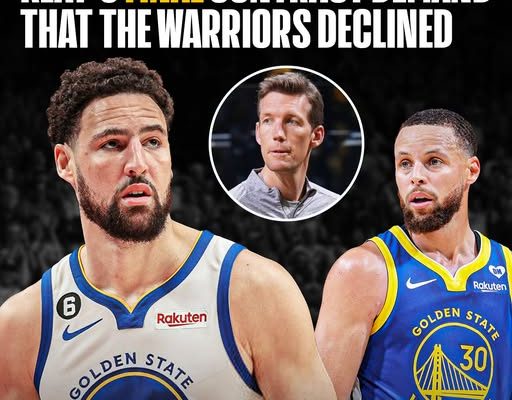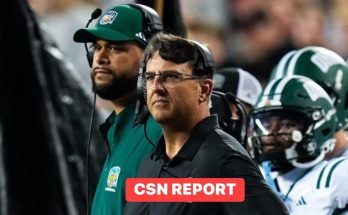Klay Thompson, one of the Golden State Warriors’ most iconic and beloved figures, recently made what can only be described as a final attempt to persuade the Warriors organization to re-sign him. This effort, however, came long after he had turned down a substantial contract extension offer from the team—a two-year deal worth $48 million. The story of Thompson’s negotiation saga is complex, filled with layers of history, expectations, and the business realities of the NBA. It also offers a window into the shifting dynamics of the Warriors’ roster construction and the evolving identity of a franchise that once seemed inseparable from the Splash Brothers duo of Stephen Curry and Klay Thompson. Understanding this episode fully requires an examination of Thompson’s career trajectory, his value to the Warriors, the nature of his contract demands, and why, despite his earnest appeal, the team ultimately declined to bring him back.
Klay Thompson’s journey with the Warriors has been nothing short of extraordinary. Drafted 11th overall in the 2011 NBA Draft, he quickly emerged as a critical component of a dynasty in the making. Alongside Stephen Curry, Thompson formed one half of the Splash Brothers, a pairing known for their unparalleled shooting prowess and ability to change games with their three-point accuracy. Over the years, Klay became synonymous with Golden State’s style—relentless defense, sharp shooting, and an unshakeable calm under pressure. His performance in the 2015, 2017, and 2018 championship runs cemented his legacy as one of the best two-way guards in the league.
However, the past several seasons have been marked by injury struggles that drastically affected Thompson’s career and, consequently, his standing with the Warriors. The devastating ACL tear in the 2019 NBA Finals followed by the Achilles rupture in 2020 sidelined him for nearly two full seasons. During this period, the Warriors had to adapt without their key two-way wing, developing new offensive and defensive schemes to compensate for his absence. When Thompson finally returned to action, his game showed signs of rust, and the Warriors themselves were in a state of flux. The team’s championship window had seemingly narrowed, with several aging veterans and a roster that was in transition.
Against this backdrop, contract negotiations between Thompson and the Warriors took on added significance. The two-year, $48 million extension offer represented a compromise that reflected both Thompson’s past contributions and the uncertainties about his future performance. It was a sizable sum, by NBA standards, for a player coming off back-to-back major injuries and trying to regain his prior level of play. The Warriors were clearly signaling that while they valued Thompson, they were cautious about overcommitting financially or roster-wise. It was a pragmatic approach, balancing respect for the player with the need for flexibility in the evolving competitive landscape.
Yet, Thompson declined this offer. The reasons behind his rejection were multifaceted. Financially, Thompson may have believed he was worth more given his championship pedigree and the market value of elite shooters in today’s NBA. Beyond money, there was likely a sense of wanting a longer-term commitment or better contract terms that would provide him with security and affirmation of his role on the team. From Thompson’s perspective, accepting the offer might have felt like settling for less than his true value, especially after all he had endured and contributed. This decision underscored the difficult balance players must navigate between loyalty to a franchise and the business realities of their career longevity and financial security.
What followed was the final push from Thompson to persuade the Warriors to reconsider. This last-ditch effort reportedly involved direct conversations, perhaps even personal appeals to the team’s management and front office. Thompson’s desire to stay with Golden State was clear—he wanted to continue being part of the Warriors’ culture, to chase another championship alongside his longtime teammates, and to finish his career where it all started. His attempt was more than just a contractual negotiation; it was an emotional plea from a player deeply tied to the franchise’s identity and success.
Despite these heartfelt overtures, the Warriors ultimately were not interested in re-signing Thompson on the terms he sought. The decision reflected a confluence of factors that went beyond the monetary. The Warriors’ front office, led by General Manager Bob Myers and head coach Steve Kerr, had to consider the broader roster construction strategy, the salary cap implications, and the potential for younger players to step into bigger roles. Thompson’s age and recent injury history made the risk of investing heavily in him more pronounced. Meanwhile, the Warriors had been quietly evolving, focusing on integrating emerging talent and creating a more versatile, modern roster capable of competing in a league that increasingly values speed, youth, and positional flexibility.
Moreover, the NBA’s salary cap structure and luxury tax penalties create a highly competitive financial environment where teams must carefully prioritize how and where they allocate their payroll. The Warriors, despite their financial muscle, could not afford to commit significant resources to a player who might not consistently deliver at his previous All-Star level. They had to weigh the potential upside of retaining a fan favorite and proven winner against the practical risks of limiting roster flexibility and future contract maneuvers.
From a basketball perspective, the Warriors have seen shifts in their playing style and personnel. With the rise of other contributors such as Jordan Poole, Andrew Wiggins, and new draft picks or acquisitions, the team is gradually reshaping its identity. While Thompson’s shooting and defense remain valuable, the coaching staff must balance his role with the need to develop these newer pieces and maintain a system that maximizes the team’s overall effectiveness. This evolution means difficult decisions are inevitable—sometimes at the expense of legacy players.
The news of Thompson’s rejected extension and his subsequent last-ditch effort sent ripples through the Warriors’ fan base and the wider NBA community. Many fans were saddened, given Thompson’s significant contributions and his status as a beloved figure in Golden State. His silhouette, iconic for countless clutch shots and lockdown defense, is emblematic of a golden era in Warriors history. Yet, the business of basketball often compels teams to make cold, calculated choices, even when they involve cherished players.
It’s worth noting that Thompson’s situation is not unique in professional sports. Veteran players coming off injuries or declining years often face tough negotiations where their loyalty and past achievements don’t always translate into guaranteed long-term deals. Teams must consider not only the present but also the future, balancing the need for veteran leadership with the imperative to remain competitive over multiple seasons.
Thompson’s legacy, however, remains intact regardless of this contract saga. He is still regarded as one of the best shooting guards of his generation and a foundational pillar in the Warriors’ championship runs. His professionalism, resilience in overcoming injuries, and unwavering commitment to team success have earned him admiration across the league. Even without a contract from Golden State, his reputation as a fierce competitor and clutch performer will endure.
Looking ahead, Thompson faces a crossroads. If he is unable to come to terms with the Warriors, he may explore opportunities elsewhere, though it is clear his heart lies in Golden State. Other teams might view him as a valuable veteran presence who can still contribute meaningful minutes, especially in shooting and perimeter defense. But Thompson’s desire to stay in the Bay Area and finish his career with the Warriors speaks volumes about his character and connection to the franchise.
From the Warriors’ perspective, this moment represents a turning point. The franchise is in transition, seeking to build a team that can compete not only now but sustainably in the years to come. The choice to pass on Thompson’s contract demand indicates a commitment to that vision, even if it means parting ways with a former superstar. It reflects the harsh realities of professional sports, where business decisions must sometimes override sentiment.



